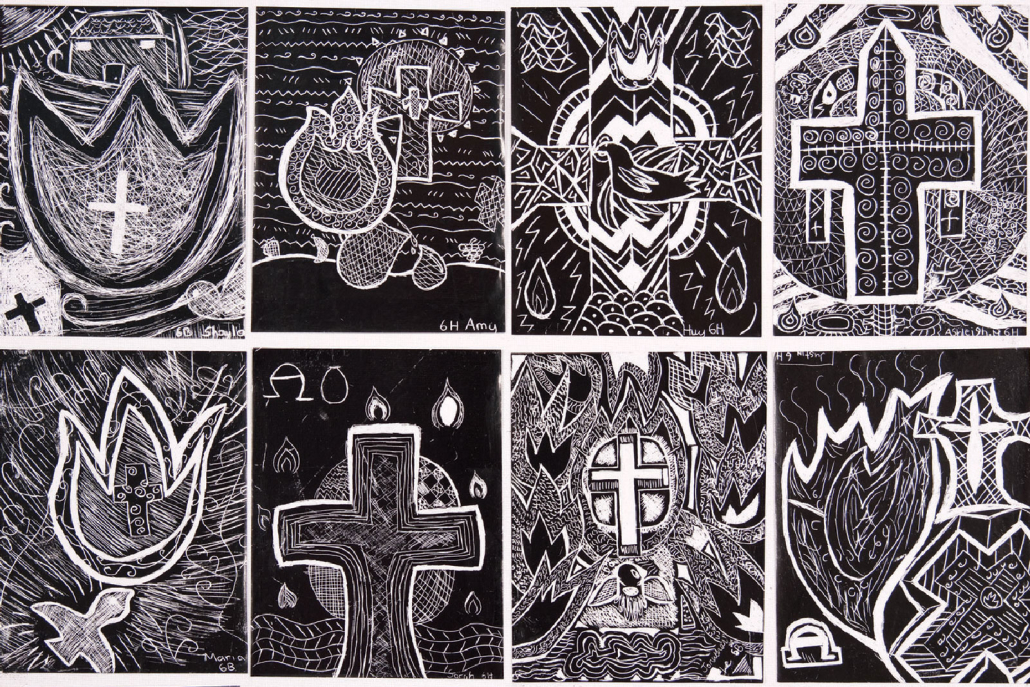Images: “Holy Spirit in Black and White” is a group piece by the Year 6 students (2012) of St Bernadette’s Primary School, Sunshine North, VIC. Students were invited to explore line through the skill of etching. Each student in the year level created their own interpretation of what the Holy Spirit means to them and depicted this image on a small piece of black and white scratch paper.
‘Dove and fire’
Andrew Collis
Easter 6, Year A
Psalm 66; John 14:15-21
There’s something about our text from John 14 that calls up ancient commentary. Perhaps it’s the promise of the Spirit, a wellspring of experience and testimony. The past recalled in present troubles – deep calling to deep (Psalm 42) – a call for help, a deeply hopeful calling.
In the past, I have recalled words from The Spiritual Writings of St Bernard, 12th-century monk, mystic and reformer:
“You will ask me how I could know the [Word’s] presence …
“My heart was as hard as a rock and stricken; he shook it, softened it, and wounded it. He it is who uproots, builds up, plants, waters the dry earth, lightens the dark places, opens locked rooms, and heats what was cold, even better, he straightens the crooked paths and levels the rough places, so much and so well that my soul blesses Abba God and all my being sings praises to the holy name …
“No movement on his part warns me of his coming, no sensation has ever hinted to me that he was entering my interior retreats … [And yet] I have perceived something of his beauty and contemplating the wonder of his greatness in all this has left me speechless.”
The incarnate Word disturbs and wounds, warms and transforms. The Word comes with a certain beauty and sense of wonder.
As for the Word, so too the new word (found only in John’s gospel). “Don’t be afraid,” Jesus says, “when I go to God, I will ask God to send you another Paraclete to be with you always.”
Paraclete is a Greek word. The first part of the word, para, means alongside or beside. The second part of the word, from kaleo, means to speak, call or cry. So, a Paraclete is someone who comes alongside you, who sits beside you, either when you are crying or calling out for help, or when you need someone to speak for you.
The Paraclete says, “I love you. I love you just as you are.” And if people are being unfair or unkind to you, the Paraclete says, “I’m proud to call this person my friend. I’m staying right here with my friend.”
A space opens between the Word made flesh and the new word, Paraclete. Between a wounded sense of beauty and wonder on the one side, and a confident sense of purpose, a dignity, on the other.
Gathering notes for this week’s homily, my eye rests on a theological work by sixth-century Pope, St Gregory the Great, who describes a balance between conflict capability and the capacity for intimacy.
Gregory’s unique way of pointing to this balance comes in his discussion of the Holy Spirit, who combines these qualities in exemplary proportion. For the Holy Spirit is symbolised by two seemingly contrary symbols – dove and fire. The wise leader learns through dialogical experience to add to meekness zeal and to temper zeal with compassion.
A space opens between the Spirit as dove and the Spirit as fire. Between a meek disposition on the one side, and a prophetic or godly authority on the other. The equilibrium is part psychological, part political. Well-being, community.
Interestingly, the protestant reformer John Calvin admired Gregory greatly, and declared in his Institutes that Gregory was the last good Pope! Of sweeter significance perhaps, he is the patron saint of musicians, singers, students and teachers.
The call, then, is not simply to be a dove. And the call is not to be fire. The call is to be part of a community where doves learn fiery passion and where fire burns dovelike.
Last night’s art opening bid us persevere, with grateful hearts and willing hands. The show, in celebration of Neighbourhood Centre Week and in collaboration with friends at Counterpoint Community Services, is called L.O.C.A.L. We pondered the meaning: Living On Country, Aboriginal Land; Learning Opportunities, Creativity And Life; Looking, Offering, Crafting, Asking, Listening …
Contributing work to an art show helps sustain a community in which certain values are upheld: inclusivity, diversity, compassion, resistance to homogenisation and consumerism (thanks to Catherine for caring and curating).
There’s something about our text from John 14 that calls up ancient commentary. Something that inspires our making images and connections. Just as it highlights the double image of dove and fire at the centre of our modern Uniting Church emblem. Amen.



